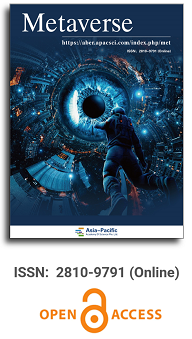
Asia Pacific Academy of Science Pte. Ltd. (APACSCI) specializes in international journal publishing. APACSCI adopts the open access publishing model and provides an important communication bridge for academic groups whose interest fields include engineering, technology, medicine, computer, mathematics, agriculture and forestry, and environment.



What is the Metaverse?—In the view of philosophical perspective
Vol 4, Issue 1, 2023
Download PDF
Abstract
What is the Metaverse actually? It is an important issue in the terms of theory and practice with huge controversy. Regarding the Metaverse from a philosophical point of view, it could better highlight the inner essence behind the controversy of representation. From the connotation view, it is a digital mapping and mirror world of universe. Extensively, it is a comprehensive integration of digital information technologies. In the view of philosophy, it is an artificial universe created by human beings with digital technology, which is digital universe corresponding to the real universe. In the view of spiritual philosophy, it is a cosmic brain created by human beings with wisdom of natural universe, which is a cosmic heart for the body of natural universe. In the view of cognitive philosophy, it is a digital universe that recognizes everything, and a digital laboratory for human innovation and creation.
Keywords
References
- Zhao G, Yi H, Xu Y. Metaverse. Beijing: China Translation & Publishing House; 2021.
- Jin X. Metaverse. In: Liu C (translator). Beijing: CITIC Press Group; 2022. p. 3–17.
- Stephenson N. Snow crash. New York: Penguin Random House; 1992. p. 14–15.
- Gong C. China Metaverse White Paper 2022 Edition [Internet]. Beijing: XDYanBao; 2022 [published 2022 Jan 26]. Available from: https://xdyanbao.com/doc/79328h73ve.
- Han M. Yuzhou de cengci yu yuanyuzhou (Chinese) [The hierarchy of the universe and the metaverse]. Philosophical Research 2002; (2): 28–34.
- Han M. Yuzhou de jiegou yanhua yu renlei de zuoyong xintan—Yuanyuzhou, benyuzhou, chaoyuzhou yu renlei (Chinese) [A new inquiry into the structure, evolution, and role of humans in the universe—The metaverse, the home-universe, the ultra-universe, and humans]. Dongyue Tribune 2002; (1): 41–49.
- Han M. Zailun yuzhou de cengci yu yuanyuzhou (Chinese) [The hierarchy of the universe and the metaverse revisited]. Philosophical Research 2002; (10): 23–26.
- Huang X, Cao X. Metaverse: Its technology and philosophical implications. Journal of Xinjiang Normal University (Edition of Philosophy and Social Sciences) 2022; 43(3): 119–126. doi: 10.14100/j.cnki.65-1039/g4.20220114.001.
- Kaku M. Parallel worlds. In: Wu Y, Bao X (translators). Chongqing: Chongqing Publishing Group; 2008. p. 35–56.
- Wiener N. Cybernetics: Or the control and communication in the animal and the machine. In: Hao J (translator). Beijing: China Science Publishing; 1962. p. 133.
- Huang X, Wang R. Metaverse, brain and body-mind of the universe. Journal of Fujian Normal University (Philosophy and Social Sciences Edition) 2022; (3): 102–112, 172. doi: 10.12046/j.issn.1000-5285.2022.03.010.
- Zhang S. Tianren zhi ji—Zhongxi zhexue de kunjing yu xuanze (Chinese) [The relationship between heaven and human—The dilemma and choice of Chinese and Western philosophy]. Beijing: Peking University Press; 2016. p. 3–11.
- Huang X. Philosophical exploration of the metaverse—From information society to cosmic brain. Theoretical Exploration 2022; (2): 5–11.
- Huang X. The metaverse, Itopia and digital creation. Journal of Shanghai Normal University (Philosophy & Social Sciences Edition) 2022; 51(5): 107–116. doi: 10.13852/J.CNKI.JSHNU.2022.05.010.
- Huang X, Cao X. Data turn of scientific cognition in the 21st century. Studies in Dialectics of Nature 2021; 37(11): 115–121. doi: 10.19484/j.cnki.1000-8934.2021.11.019.
Supporting Agencies
Copyright (c) 2023 Xinrong Huang

This work is licensed under a Creative Commons Attribution 4.0 International License.

This site is licensed under a Creative Commons Attribution 4.0 International License (CC BY 4.0).

Prof. Zhigeng Pan
Professor, Hangzhou International Innovation Institute (H3I), Beihang University, China

Prof. Jianrong Tan
Academician, Chinese Academy of Engineering, China
Conference Time
December 15-18, 2025
Conference Venue
Hong Kong Convention and Exhibition Center (HKCEC)
...
Metaverse Scientist Forum No.3 was successfully held on April 22, 2025, from 19:00 to 20:30 (Beijing Time)...
We received the Scopus notification on April 19th, confirming that the journal has been successfully indexed by Scopus...
We are pleased to announce that we have updated the requirements for manuscript figures in the submission guidelines. Manuscripts submitted after April 15, 2025 are required to strictly adhere to the change. These updates are aimed at ensuring the highest quality of visual content in our publications and enhancing the overall readability and impact of your research. For more details, please find it in sumissions...






.jpg)
.jpg)

